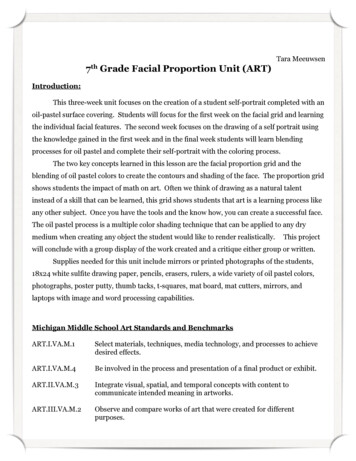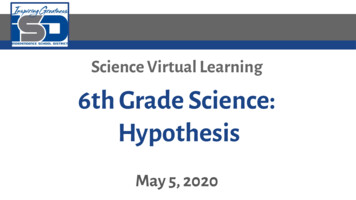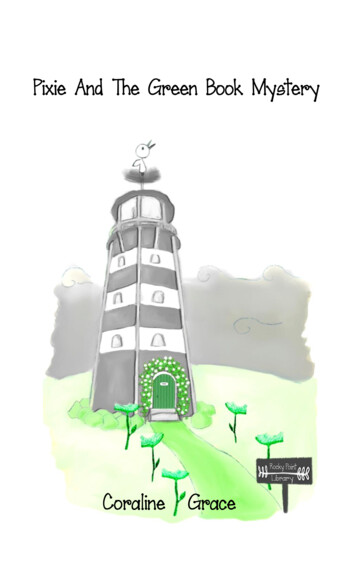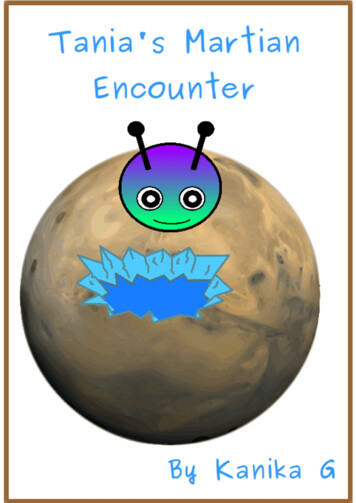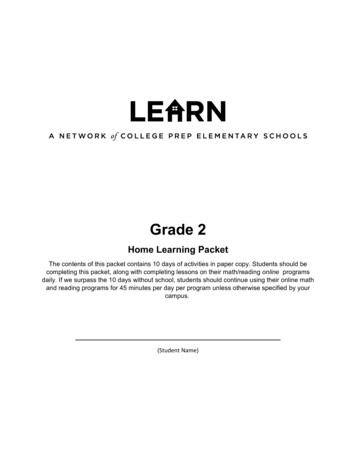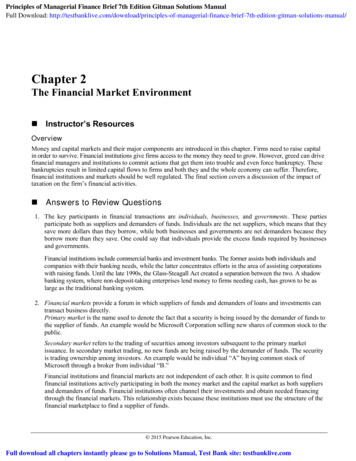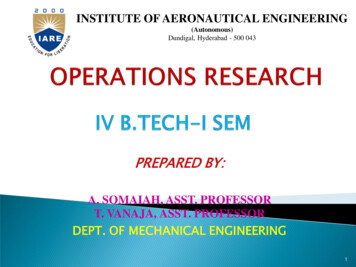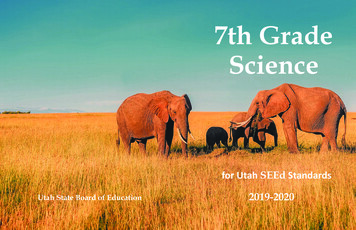
Transcription
7th GradeSciencefor Utah SEEd StandardsUtah State Board of Education2019-2020
th7 Gradefor Utah SEEd StandardsUtah State Board of Education OER2019-2020
To access a customizable version of this book, as well as otherinteractive content, visit www.ck12.orgCK-12 Foundation is a non-profit organization with a mission to reducethe cost of textbook materials for the K-12 market both in the U.S. andworldwide. Using an open-source, collaborative, and web-basedcompilation model, CK-12 pioneers and promotes the creation anddistribution of high-quality, adaptive online textbooks that can bemixed, modified and printed (i.e., the FlexBook textbooks).Copyright 2019 CK-12 Foundation, www.ck12.orgThe names “CK-12” and “CK12” and associated logos and the terms“FlexBook ” and “FlexBook Platform ” (collectively “CK-12 Marks”)are trademarks and service marks of CK-12 Foundation and areprotected by federal, state, and international laws.Any form of reproduction of this book in any format or medium, inwhole or in sections must include the referral attribution linkhttp://www.ck12.org/saythanks(placed in a visible location) in addition to the following terms.Except as otherwise noted, all CK-12 Content (including CK-12Curriculum Material) is made available to Users in accordance withthe Creative Commons Attribution-Noncommercial 3.0 Unported (CCBY-NC 3.0) License (http://creativecommons.org/ licenses/bync/3.0/), as amended and updated by Creative Commons from time totime (the “CC License”), which is incorporated herein by this reference.Complete terms can be found at http://www.ck12.org/about/ terms-ofuse.Printed: May, 2019For online attribution CK-12 FoundationLicensed under Terms of Use Attribution1AUTHORUSBE OER
Table of Contents9CHAPTER 11.1 Forces and Motion (7.1.1)101.2 Action and Reaction (7.1.2)131.3 Electric and Magnetic Forces (7.1.3)171.4 Strength of Electric and Magnetic Forces (7.1.4)251.5 Gravity (7.1.5)2934CHAPTER 22.1 The Rock Cycle (7.2.1)352.2 Earth’s Surface Changes over Time (7.2.2)392.3 Engineering and Geologic Hazards (7.2.3)452.4 Earth’s Interior (7.2.4)512.5 Patterns in Plate Tectonics (7.2.5)582.6 How Old is the Earth (7.2.6)6572CHAPTER 33.1 Cells are the Building Blocks of Life (7.3.1)723.2 Function of Cell Parts (7.3.2)783.3 Organization of the Human Body (7.3.3)8491CHAPTER 44.1 Types of Reproduction (7.4.1)914.2 Adaptations for Reproduction (7.4.2)994.3 Mutations (7.4.3)1054.4 Genetic Changes Caused by Humans (7.4.4)109115CHAPTER 55.1 Developing Traits that Affect Survival (7.5.1)1165.2 Changes to Life over Time (7.5.2)1245.3 Connecting Modern Organisms to Ancient Organisms (7.5.3)1295.4 Comparative Embryology (7.5.4)1352
Credits and CopyrightCredits Copyright, Utah State Board of Education, 2019.Unless otherwise noted, the contents of this book are licensed under the Creative CommonsAttribution NonCommercial ShareAlike license. Detailed information about the license isavailable online at egalcodeUnless otherwise attributed, photos were taken from the ck-12 website and Pixabay.Prior to making this book publicly available, we have reviewed its contents extensively todetermine the correct ownership of the material and obtain the appropriate licenses to makethe material available. We will promptly remove any material that is determined to beinfringing on the rights of others. If you believe that a portion of this book infringes another’scopyright, contact Ricky Scott at the Utah State Board of Education:richard.scott@schools.utah.gov .If you do not include an electronic signature with your claim, you may be asked to send orfax a follow-up copy with a signature. To file the notification, you must be either the copyrightowner of the work or an individual authorized to act on behalf of the copyright owner. Yournotification must include: Identification of the copyrighted work, or, in the case of multiple works at the same location,a representative list of such works at that site. Identification of the material that is claimed to be infringing or to be the subject of infringingactivity. You must include sufficient information, such as a specific page number or otherspecific identification, for us to locate the material. Information for us to be able to contact the claimant (e.g., email address, phone number). A statement that the claimant believes that the use of the material has not been authorizedby the copyright owner or an authorized agent. A statement that the information in the notification is accurate and that the claimant is, oris authorized to act on behalf of, the copyright owner.This book is adapted primarily from the excellent materials created by the CK-12 Foundation- http://ck12.org/ - which are licensed under the Creative Commons Attribution NonCommercial Share Alike license. We express our gratitude to the CK-12 Foundation for theirpioneering work on secondary science textbooks, without which the current book would notbe possible.We especially wish to thank the amazing Utah science teachers whose collaborative effortsmade the book possible. Thank you for your commitment to science education and Utahstudents!3
Students as ScientistsWhat does science look and feel like?If you’re reading this book, either as a student or a teacher, you’re going to be digginginto the “practice” of science. Probably, someone, somewhere, has made you thinkabout this before, and so you’ve probably already had a chance to imagine thepossibilities. Who do you picture doing science? What do they look like? What are theydoing?Often when we ask people to imagine this, they draw or describe people with lab coats,people with crazy hair, beakers and flasks of weird looking liquids that are bubbling andfrothing. Maybe there’s even an explosion. Let’s be honest: Some scientists do look likethis, or they look like other stereotypes: people readied with their pocket protectors andcalculators, figuring out how to launch a rocket into orbit. Or maybe what comes to mindis a list of steps that you might have to check off for your science fair project to bejudged; or, maybe a graph or data table with lots of numbers comes to mind.So let’s start over. When you imagine graphs and tables, lab coats and calculators, isthat what you love? If this describes you, that’s great. But if it doesn’t, and that’s probablytrue for many of us, then go ahead and dump that image of science. It’s useless becauseit isn’t you. Instead, picture yourself as a maker and doer of science. The fact is, weneed scientists and citizens like you, whoever you are, because we need all of the ideas,perspectives, and creative thinkers. This includes you.Scientists wander in the woods. They dig in the dirt and chip at rocks. They peer throughmicroscopes. They read. They play with tubes and pipes in the aisles of a hardwarestore to see what kinds of sounds they can make with them. They daydream andimagine. They count and measure and predict. They stare at the rock faces in themountains and imagine how those came to be. They dance. They draw and write andwrite and write some more.Scientists — and this includes all of us who do, use, apply, or think about science —don’t fit a certain stereotype. What really sets us apart as humans is not just that weknow and do things, but that we wonder and make sense of our world. We do this inmany ways, through painting, religion, music, culture, poetry, and, most especially,science. Science isn’t just a method or a collection of things we know. It’s a uniquelyhuman practice of wondering about and creating explanations for the natural worldaround us. This ranges from the most fundamental building blocks of all matter to thewidest expanse of space that contains it all. If you’ve ever wondered “When did timestart?”, or “What is the smallest thing?”, or even just “What is color?”, or so many otherendless questions then you’re already thinking with a scientific mind. Of course you are;you’re human, after all.4
But here is where we really have to be clear. Science isn’tjust questions and explanations. Science is about a senseof wondering and the sense-making itself. We have towonder and then really dig into the details of oursurroundings. We have to get our hands dirty. Here’s agood example: two young scientists under the presence ofthe Courthouse Towers in Arches National Park. We canbe sure that they spent some amount of time in awe of thegiant sandstone walls, but here in this photo they’reenthralled with the sand that’s just been re-washed byrecent rain. There’s this giant formation of sandstonelooming above these kids in the desert, and they’re happilyplaying in the sand. This is ridiculous. Or is it?How did that sand get there? Where did it come from? Did the sand come from the rockor does the rock come from sand? And how would you know? How do you tell this story?Look. There’s a puddle. How often is there a puddle in the desert? The sand is wet andfine; and it makes swirling, layered patterns on the solid stone. There are pits andpockets in the rock, like the one that these two scientists are sitting in, and the grittysand and the cold water accumulate there. And then you might start to wonder: Doesthe sand fill in the hole to form more rock, or is the hole worn away because it becamesand? And then you might wonder more about the giant formation in the background: Ithas the same colors as the sand, so has this been built up or is it being worn down?And if it’s being built up by sand, how does it all get put together; and if it’s being wornaway then why does it make the patterns that we see in the rock? Why? How long?What next?Just as there is science to be found in a puddle or a pit or a simple rock formation,there’s science in a soap bubble, in a worm, in the spin of a dancer and in the structureof a bridge. But this thing we call “science” is only there if you’re paying attention, askingquestions, and imagining possibilities. You have to make the science by being theperson who gathers information and evidence, who organizes and reasons with this,and who communicates it to others. Most of all, you get to wonder. Throughout all of therest of this book and all of the rest of the science that you will ever do, wonder shouldbe at the heart of it all. Whether you’re a student or a teacher, this wonder is what willbring the sense-making of science to life and make it your own.Adam JohnstonWeber State University5
Science and Engineering PracticesScience and Engineering Practices are what scientists do to investigate and explorenatural phenomena.6
Cross Cutting ConceptsCrosscutting Concepts are the tools that scientists use to make sense of naturalphenomena.7
A Note to TeachersThis Open Educational Resource (OER) textbook has been written specifically forstudents as a reputable source for them to obtain information aligned to the 7th GradeScience Standards. The hope is that as teachers use this resource with their students,they keep a record of their suggestions on how to improve the book. Every year, thebook will be revised using teacher feedback and with new objectives to improve thebook.If there is feedback you would like to provide to support future writing teams please usethe following online survey: http://go.uen.org/b628
CHAPTER1Strand 1: Forces Interact with MatterChapter Outline1.1 FORCES AND MOTION (7.1.1)1.2 ACTION AND REACTION (7.1.2)1.3 ELECTRIC AND MAGNETIC FORCES (7.1.3)1.4 STRENGTH OF ELECTRIC AND MAGNETIC FORCES (7.1.4)1.5 GRAVITY (7.1.5)Pixabay.com CC0Forces are push or pull interactions between two objects. Forces on matter aid allchanges in motion, balance and stability, and transfer of energy. Forces can includeelectric, magnetic, and gravitational forces. Forces can act on objects that are not incontact with each other. Scientists use data from many sources to examine the causeand effect relationships determined by different forces.9
1.1 Forces and Motion (7.1.1)Explore this Phenomenon1. This image shows a rolling ballfountain as seen Hogle Zoo orLagoon. When you approach the ballit is not moving. How could you get theball to move?2. If you push the ball, it will beginmoving. When you let go of the ball itwill continue moving. Why does theball continue to move?3. What would happen if you pushedthe ball in a different direction?Hogle Zoo’s Rolling Ball Fountain by ShaunaChapa, CC BY4. If you are not touching the ball and it begins to slow down or stop, what causes theball to slow and stop?5. What other questions do you have about the movement of the ball?10
7.1.1 Forces and MotionCarry out an investigation which provides evidence that a change in an object'smotion is dependent on the mass of the object and the sum of the forces acting on it.Various experimental designs should be evaluated to determine how well theinvestigation measures an object's motion. Emphasize conceptual understanding ofNewton's First and Second Laws. Calculations will focus on one dimension; the use ofvectors will be introduced in high school.It is important as you read this chapter to understand that the stability orchange of an object is directly related to the mass of the object and whatforces are acting on it. Unbalanced forces cause a change in motion,while balanced forces create stability.Force and MotionThe English scientist Isaac Newton, who livedaround 1700, was curious about how forcesaffect the motion of objects. After a lot of studyand observations he was able to explain therelationship between forces and motion.Public DomainNewton observed a pattern in the relationshipbetween force (a push or pull) and motion. Henoticed a force is needed to make a stationaryobject start moving. A moving object will onlyslow down, speed up, or change direction if anoutside force pushes or pulls it. In other words,objects tend to stay in whatever state they arein (motion or rest) unless another force acts onthem. This property is called inertia and isknown as Newton’s First Law. Consider whathappens when you roll a ball across afloor. According to Newton’s first law the ballshould keep rolling until a force acts on it tomake it stop rolling. What force makes the ballstop rolling?11
Push by Phil Dolby, https://flic.kr/p/oziprjIn the picture above you can see the two children exerting a force on the ball to move itacross the grass. If they do not push on it, it will not move.Along with forces, Newton observed another property that affects how an object’smotion changes the mass of the object. The relationship between the force on an object,its mass, and how its motion changes is called Newton’s Second Law. How would theforce needed to push a full shopping cart be different from the force needed to push anempty shopping cart? How is the amount of force needed to move an object related tothe object’s mass?The motion of an object is determined by the sum of the forces acting on it. The greaterthe mass of the object, the greater the force needed to achieve the same change inmotion.Changes in MotionThere are always forces acting on every object. If an object is at rest, it means that theforces acting on that object are balanced. If an object is in motion, it means that theforces acting on that object are unbalanced. If you have a pencil resting on your desk,the forces on your pencil are balanced. When your pencil moves the forces acting on itare unbalanced. Can you think of what forces may be acting on it while it is at rest?How can you add a force to your pencil to make it move?12
Putting It Together1. Now that you understand forces, whywas the ball at rest when you firstapproached it?2. Use what you know about mass,force and motion to explain what ishappening when you push the ball?Hogle Zoo’s Rolling Ball Fountain by ShaunaChapa, CC BY3. Explain what is happening when the ball continues to roll, when you stop touchingit.4. When the ball is moving, are the forces balanced or unbalanced?13
1.2 Action and Reaction (7.1.2)Explore this PhenomenonSometimes when people go rifle shooting and use a scope on their gun, they end upwith the type of injury shown in the picture above. First, they put the rifle butt to theirshoulder, aim through the scope and shoot. Then .OUCH! As you read the followingsection, think of what may have caused this injury.14
7.1.2 Action and ReactionApply Newton’s Third Law to design a solution to a problem involving the motion oftwo colliding objects in a system. Examples could include collisions between two movingobjects or between a moving object and a stationary objectAs you read, try to imagine two colliding objects as a system. Think aboutwhat forces or energy are going into the system and out of the system.What impact do those forces have on the system as a whole? Scientistsand engineers are always looking for ways to reduce the damage that mightbe caused when two objects collide.Action and ReactionWhenever you apply a force to an object, it applies the same force back on you. Theseforces are equal and act in opposite directions. This is Newton’s Third Law, which statesthat every action has an equal and opposite reaction.Think of a Newton’s cradle as seen inthe image. When a sphere on one endis lifted and released, it will collide withthe other spheres.The collisiontransfers energy to the other spheres.The sphere on the far end will swing outfrom the transferred energy. The lastsphere then impacts the row of spheresagain and the energy is transferredback through the sphere and causesthe original sphere to swing out again.The spheres will continue this motionuntil the forces become balancedagain.Just because the forces are equal andopposite does not mean that they havethe same effect. When you kick asoccer ball, you apply a force to theball, and it pushes back on you with thesame force. If the forces are equal, whydoes the soccer ball move and youdon’t?Pixabay.com, CC0You have a lot more mass than the soccer ball. Remember that the more mass an objecthas, the more force is needed to move it. The force acting on the soccer ball is bigenough to make the ball move. The opposite force acting on you is not big enough tomake you move because you have more mass.15
If two skaters were to push on each other’s palms,the skaters would move backward, away from eachother. What would happen if the skaters just usedone finger to push off each other?Benjamin Crowell(Wikipedia user bcrowell)Another example is when you release the airout of a balloon. If you let go of a balloonwithout tying it closed, the air rushes out of theballoon and the balloon goes flying in the otherdirection.Ck12.org, CC BY-SAIf a car hits a tree, the tree pushesback on the car. Damage to the carand/or the tree depends on whatfactors?Wikimedia Commons16
Putting It Together2 Stitches! by JohnLet us revisit this phenomenon:1. Create a model that shows the forces involved when a person shoots a gun.2. Now, design a solution that shooters might use to help protect them from injury.17
1.3 Electric and Magnetic Forces (7.1.3)Explore this Phenomenon #1Electric Slide by Ken Bosma,https://flic.kr/p/5keFrC, CC BYAt the park, you see a child coming down the slide with hair sticking straight up.1. What is causing this to happen?As you read the following section, think of possible models you could build to showwhat causes the child’s hair to stand up.18
7.1.3 Electric and Magnetic ForcesConstruct a model using observational evidence that describes the nature of fieldsexist between objects that exert forces on each other even though the objects are notin contact. Emphasize the cause and effect relationship between properties of objects(such as magnets or electrically-charged objects) and the forces they exert.In this chapter, see if you can identify the causes and effects ofelectric and magnetic forces. As you observe forces try to identifythe cause of each force. We can use cause and effect to help uspredict what might happen in similar situations.Introducing Electric ChargeElectric charge is a physical property. It occurs between particles or objects. It causesthem to attract or repel each other. They do not even have to touch. This is unlike thetypical push or pull you may be familiar with (as discussed in section 7.1.1 in Forces inMotion). All electric charge is based on the protons and electrons in atoms. As in theimage below, a proton has a positive electric charge ( ); and an electron has a negativeelectric charge(-).Public DomainElectric ForceWhen it comes to electric charges, opposites attract. In other words, positive andnegative particles are attracted to each other. Charges that are the same, like charges,repel each other. If two positive charges are brought close to each other, they will repelor push away from each other. The same is true with two negative charges. They toowill repel each other. What if a negative and a positive charge are brought near eachother? They will be attracted to each other and the force of attraction will try to pull them19
closer together. Can you think of an example of invisible forces that attract or repeleach other?CC0The force of attraction or repulsion between charged particles is called electric force.The strength of the electric force depends on several factors. It depends on how manynegatively and positively charged particles there are. It also depends on the distancebetween the charged particles. How do you think the force will change if you increasethe distance? How do you think the force will change if you decrease the distance?Static ElectricityStatic electricity is a buildup of electric chargeson objects. Charges build up when negativecharges (electrons) are transferred from oneobject to another. This happens when you rub aballoon on your hair. Electrons from your hair aretransferred to the balloon and the balloonbecomes negatively charged. Your hair gives upelectrons and becomes positively charged.Pictured below is another example of staticelectricity.Electric by Kate Brady,https://flic.kr/p/bFuNQ, CC BY-SAWikipedia CC BY 2.020
Putting It TogetherElectric Slide by Ken Bosma,https://flic.kr/p/5keFrC, CC BYLet us revisit this phenomenon:1. Using your knowledge of electric forces, explain what causes your hair to stand upfrom static electricity.2. Create, draw or find a model to help illustrate your explanation21
Explore this Phenomenon #2This roller coaster at Lagoon Amusement Park is not powered the way that most rollercoasters are. Most roller coasters have a chain that pulls the car out of the station andup the first hill.This coaster depends on magnets to travel out of the station and up the first hill. As youread the following section, think of possible models you could build to explain howmagnets push the train forward and cause it to move so fast.22
Magnetic Force and Magnetic FieldThe force that a magnet exerts on certain materials, including other magnets, is calledmagnetic force. This force is similar to the electric force because the particles do nothave to touch. A magnet can exert force over a distance because it is surrounded by amagnetic field. In the figure below, you can see the magnetic field surrounding a barmagnet. Tiny bits of iron, called iron filings, were placed on a sheet of paper. When amagnet was placed under the paper, it attracted the iron filings. The pattern of the ironfilings shows the lines of force that make up the magnetic field of the magnet. Theconcentration of iron filings near the poles (the ends) indicates that these areas exertthe strongest force.Ck12.org, CC BY-SA23
Magnetics can either attract matter or repel matter. If you put two magnets close withthe same poles facing each other, they will repel each other. The following two picturesshow magnets repelling each other, as evidence by the iron fillings.Wikimedia Commons, CC BY-SACk12.org, CC BY-SA24
Putting It TogetherLet us revisit this phenomenon:Magnets are used on the track and on the cars to make the roller coaster move.1. Create a model or diagram showing how magnets would start the train movingforward.25
1.4 Strength of Electric and MagneticForces (7.1.4)Explore this PhenomenonElectromagnet by GinaClifford, https://flic.kr/p/4rqaeL,You can turn a nail into a magnet by wrapping a wire around it and connecting the wireto a battery. As you read the following section, think of how you could collect andanalyze data as to what factors may affect the strength of this magnet.26
7.1.4 Factors that Affect the Strength ofElectric and Magnetic ForcesCollect and analyze data to determine the factors that affect the strength of electricand magnetic forces. Examples could include electromagnets, electric motors, orgenerators. Examples of data could include the effect of the number of turns of wire onthe strength of an electromagnet, or of increasing the number or strength of magnetson the speed of an electric motor.Magnets and electrical forces can exert different amounts ofstrength. In this section, pay special attention to how makingchanges to the magnets and electrical forces can cause a changein the strength or effect of these forces.ElectromagnetsOne of the most famous electric carcompanies is Tesla, named after NikolaTesla. These electric cars require anelectromagnet to run the engine.Our knowledge of electromagnets wasdeveloped from a series of observations. In1820, Hans Oersted discovered that acurrent-carrying wire produces a magneticfield. Later in the same year, André-MarieCk12.org, CC BY-SAAmpere discovered that a coil of wire actedlike a permanent magnet and François Aragofound that an iron bar could be magnetizedby putting it inside of a coil of current-carrying wire. Finally, William Sturgeon found thatleaving the iron bar inside the coil greatly increased the magnetic field.Two major advantages of electromagnets are that they have extremely strong magneticfields, and that the magnetic field can be turned on and off. When the current flowsthrough the coil, it is a powerful magnet. When the current is turned off, the magneticfield essentially disappears.Electromagnets are used in many practical applications. They can lift large masses ofmagnetic materials such as scrap iron, rolls of steel, and auto parts.The overhead portion of the machine shown in the next image is a lifting electromagnet.It is lowered to the deck where steel pipe is stored and it picks up a length of pipe andmoves it to another machine where it is set upright and lowered into an oil well drill hole.Electromagnets are essential to the design of the electric generator and electric motorand are also employed in doorbells, circuit breakers, television receivers, loudspeakers,electric deadbolts, car starters, clothes washers, atomic particle accelerators, and27
electromagnetic brakes and clutches.Electromagnets are commonly used asswitches in electrical machines. A recentuse for industrial electromagnets is tocreate magnetic levitation systems forbullet trains.Electric GeneratorsAn electric generator is a device thatgenerates an electric current using amagnetic field. Electricity can begenerated when a magnetic field and anelectric conductor, such as a coil of wire,move relative to one another.Ck12.org, CC BY-SAA simple diagram of an electricgenerator is shown in the image below. In any electric generator, some form of energyis applied to turn a shaft. The turning shaft causes a coil of wire to rotate between theopposite poles of a magnet. Because the coil is rotating in a magnetic field, electriccurrent is generated in the wire.Ck12.org, CC BY-SAOnline Interactive Activity: http://go.uen.org/aZC28
Putting It TogetherElectromagnet by Gina Clifford, https://flic.kr/p/4rqaeL, CC BY-SALet us revisit this phenomenon:1.You can build a simple electromagnet using a battery, wire, and nail. Whichfactor(s) affect how strong the electromagnet is?B.C.D.E.The diameter of the wire.The voltage of the battery.The size of the nail.The number of times you wrap the wire around the nail.29
1.5 Gravity (7.1.5)Explore this PhenomenonNASA, Public DomainAccording to NASA, it takes 1,607,185 pounds of fuel to launch a space shuttle fromEarth. As you read the following section, engage in argument using evidence to answerthe claim that it will take the same amount of fuel to launch a space shuttle from theMoon.30
7.1.5 GravityEngage in argument from evidence to support the claim that gravitational interactionswithin a system are attractive and dependent upon the masses of interacting objects.Examples of evidence for arguments could include mathematical data generated fromsimulations or digital tools.Systems can be big or small. A system model can be used to show the energythat goes in and out of a system. A system consists of all the parts (matter)that are in the system and everything that is affecting the system.What is Gravity?Gravity has traditionally been defined as a force of attraction between things that havemass. According to this concept of gravity, anything that has mass, no matter how small,exerts gravity on other matter. Gravity can act between objects that are not eventouching. In fact, gravity can act over very long distances, but the farther apart theobjects are, the weaker the force of gravity between them is.Mass Influences the Strength of GravityThe strength of gravity between any two objects depends on two factors: the masses ofthe objects and the distance between them. An object with more mass will have astronger gravitational pull. For example, because Earth is so massive, it attracts yourdesk, holding it to the ground, more than you can attract your desk. There is a force ofgravity between Earth and you and between you and all the objects around you. Whenyou drop a paperclip, why doesn’t it fall toward you instead of toward Earth?If we look at our solar system, the Sun’s mass is about 98% of the total mass of thesolar system. Our eight planets are exerting a force on the Sun a
2 Table of Contents CHAPTER 1 9 1.1 Forces and Motion (7.1.1) 10 1.2 Action and Reaction (7.1.2) 13 1.3 Electric and Magnetic Forces (7.1.3) 17 1.4 Strength of Elect
